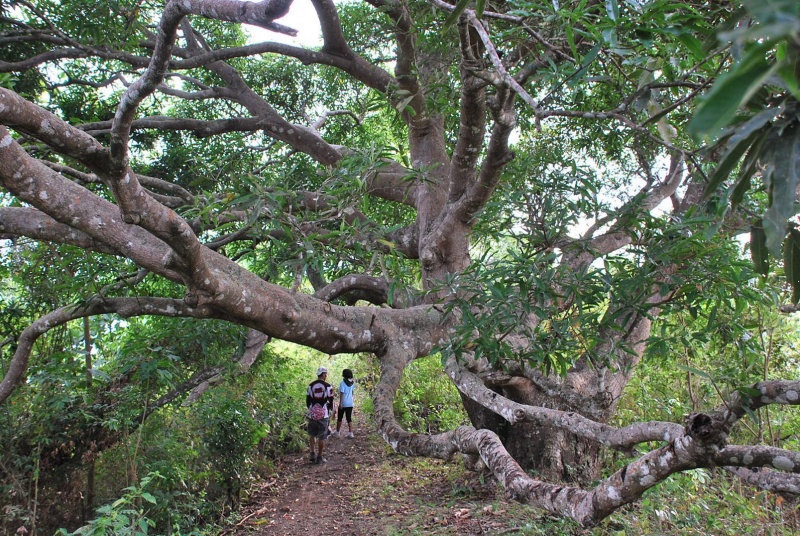Are you familiar with the Tindalo tree? Also known as Balayong, this tropical hardwood species is native to Southeast Asia and has been prized for its exceptional qualities for centuries. From its stunning appearance to its remarkable strength, the Tindalo tree boasts a range of characteristics that make it a desirable material for various applications. Join us as we explore the fascinating world of the Tindalo tree, uncovering its unique features and discovering how it is used today.
Tindalo Tree Description and Characteristics
Scientifically known as Afzelia rhomboidea, the Tandalo tree is also commonly referred to as Balayong. This tropical hardwood species can grow up to 30 meters tall and has a diameter of 50-80 centimeters.
The Tindalo tree features compound leaves with smooth and glossy leaflets on top while hairy underneath. In the early stages of growth, its flowers appear in cream or yellow-colored clusters before eventually developing into seed pods that contain several seeds.

What sets this species apart is its unique wood coloration, ranging from a light pinkish-brown hue when freshly cut to a deep reddish-brown shade over time. The Tindalo’s wood grain pattern varies but typically appears interlocked with occasional wavy lines.
Furthermore, the Tindalo tree offers exceptional hardness levels that make it highly resistant to wear and tear – making it an excellent material for flooring and furniture production. Its durability stems from its natural oils, which help protect against decay caused by insects or fungi.
The Tindalo tree boasts an impressive array of characteristics that have made it famous throughout history for various applications – from traditional boat-building techniques to modern construction projects today.
Tindalo Wood Uses and Applications
Tindalo wood, derived from the majestic Tindalo tree, has long been prized for its unique qualities and versatility. This highly sought-after timber boasts a rich, dark brown hue that exudes class and sophistication. The fine texture and interlocked grain pattern add to its visual appeal, making it ideal for various applications.
One of the most common uses of Tindalo wood is in furniture making. Due to its remarkable strength and durability, it’s perfect for crafting pieces such as tables, chairs, cabinets, and beds that can last generations. Additionally, the natural resistance to termites makes this type of wood even more desirable in tropical regions.
Aside from furniture production, Tindalo wood is also popular in boat building. Its inherent water resistance properties make it an excellent choice for constructing hulls or other parts exposed to moisture.
In interior design projects like flooring or decorative wall paneling installation, architects often opt to utilize this exceptional hardwood because it not only provides a stunning appearance but also ensures longevity without constant upkeep requirements.
This exquisite timber is used in creating beautiful handicrafts due to its ability to be easily carved while retaining structural integrity. Artisans frequently create intricate sculptures or ornamental pieces using Tindalo wood as their medium – showcasing cultural narratives through these remarkable works of art.
Conservation Status and Other Challenges
The tindalo tree has faced numerous threats in recent years, with its conservation status being a major concern. Due to overexploitation and habitat loss, the tree is classified as “vulnerable” on the IUCN Red List. With the high demand for wood, illegal logging activities have increased, leading to a decline in the population of this species.
Apart from human activities, climate change also poses a threat to the tindalo tree. As temperatures rise and rainfall patterns change, it becomes harder for these trees to survive. If measures are not taken, this could potentially lead to their extinction.
Conservation efforts, such as reforestation programs and sustainable logging practices, are necessary to ensure that the tindalo tree does not face complete extinction. We must educate people about the importance of preserving our ecosystem and take action to protect endangered plant species like this one.
In addition, collaborations between governments and local communities can promote conservation through community-managed forests and ecotourism initiatives which help generate an income while maintaining ecological balance.
We must work towards conserving this valuable resource for future generations by addressing human-induced factors like unsustainable logging practices and natural causes such as climate change impacts on forest ecosystems.
Final Words
Tindalo, also known as balayong, is a magnificent tree that boasts of various features and benefits. Its beautiful appearance, durability, and versatility make it an ideal choice for many applications.
As we appreciate the beauty and usefulness of tindalo wood, let us not forget the challenges surrounding its conservation status. With rampant deforestation and illegal logging activities happening worldwide, we must advocate for responsible forestry practices that protect our environment while utilizing natural resources like tindalo sustainably.
Tindalo is a valuable addition to any ecosystem or industry that can benefit from its unique qualities. Let us continue to recognize the importance of this species in our lives while making efforts to protect it so future generations can enjoy its beauty, too.
See Also:
- Ipil Tree Characteristics and Uses
- Mangkono Tree Characteristics and Uses
- Kamagong Wood Characteristics and Uses
- Acacia Tree Description, Characteristics, and Uses
- Amugis Tree Description, Characteristics, and Uses
